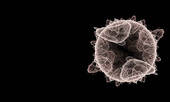Movement of Bacteria
Bacteria move in different ways. Cocci rarely show active motility. They are transmitted in the air, in dust, or within the surface in which they settle. Bacilli and spirilla use hair-like extentions called flagella or cilia for movement.

Bacilli using flagella for movement
Growth and Reproduction
The life-cycle of bacteria consists of two distinct phases. These are the active stage and the inactive, or spore-forming stage.
In the active stage, bacteria grow and reproduce. Bacteria multiply best in warm, dark, damp, or dirty places where food is available. When they reach their largest size, they divide. This divison is called mitosis. The new cells are called daughter cells. Once conditions become unfavorable, the bacteria either die or become inactive.

Mitosis
In the inactive or spore-forming stage, bacteria coat themselves with waxy outer shells that are able to withstand long periods of famine, dryness, and unsuitable temperatures. They can be blown about and not harmed by heat, cold, or disinfectants. When conditions become favorable, the spores change into the active form and begin to grow and reproduce.

Spore-Forming Stage
Bacterial Infections

Pathogenic bacteria cause bacterial infections. The presence of pus is a sign of a bacterial infection.
Staphylococci are amoung the most common human bacteria. It is transmitted on doorknobs, countertops, skin-to-skin contact, and using unclean implements. Staph is also responsible for food poisoning. Some strains are very resistant .
A local infection, such as a pimple or abscess, is one that is confined to a particular part of the body and is indicated by a lesion containing pus. A general infection results when the bacteria is in the bloodstream and is carried throughout the body. Syphilis is an example.
When a disease spreads from one person to another by contact, it is said to be contagious or communicable. Common contagious diseases that may prevent you from servicing a client are the common cold, ringworm, pinkeye, and viral infections. These infections are spread through dirty hands and implements, open sores, pus, mouth and nose discharges, shared drinking cups, telephone receivers, and towels. Uncovered coughing or sneezing in public also spreads germs.



